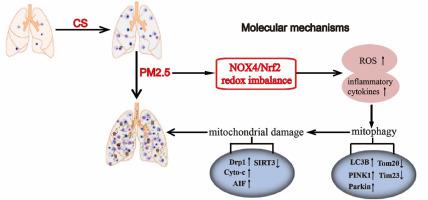环境中细颗粒物 (PM2.5) 的增加增加了慢性阻塞性肺病急性加重 (AECOPD) 的易感性。在 PM2.5 暴露期间,过量的活性氧 (ROS) 产生会引发氧化还原失衡,从而导致细胞器受损和体内平衡破坏。目前关于NOX4/Nrf2氧化还原失衡是否增加慢性阻塞性肺病急性加重(AECOPD)易感性的资料有限,其机制尚不清楚。因此,本研究旨在评估 NOX4/Nrf2 氧化还原平衡对 PM2.5-CS 暴露诱导的 AECOPD 的作用。在这里,我们报告 PM2.5 通过增强 NOX4/Nrf2 氧化还原失衡介导的线粒体自噬来加剧细胞毒性。首先,接触低剂量的 PM2.5。5 (200 μg/ml) 通过增加 ROS 过量产生、增强过度的 NOX4/Nrf2 氧化还原失衡、降低线粒体膜电位 (MMP) 以及增强由低浓度引起的线粒体断裂来显着加剧氧化应激和线粒体损伤CSE 剂量 (2.5%)。其次,同时暴露于 PM2.5 和 CSE (PM2.5-CSE) 会导致过度的线粒体自噬。第三,PM2.5 加剧了 CS 诱导的 COPD,表现为炎症细胞过度浸润、炎症细胞因子产生和粘液分泌过多、杯状细胞增生、NOX4/Nrf2 氧化还原失衡和线粒体自噬,这些作用引发小鼠 ROS 过度产生和线粒体损伤. 从机制上讲,PM2.5-CS 通过触发氧化还原失衡诱导过度水平的线粒体自噬,从而导致更大的细胞毒性和 AECOPD;然而,通过 NOX4 阻断或线粒体特异性 ROS 抑制剂治疗重建 NOX4/Nrf2 氧化还原平衡减轻了这种细胞毒性并改善了 AECOPD。PM2.5 可能加剧 NOX4/Nrf2 氧化还原失衡,随后通过增加 ROS 和 mito-ROS 水平增强线粒体自噬,从而增加对 AECOPD 的易感性。
 "点击查看英文标题和摘要"
"点击查看英文标题和摘要"
PM2.5 increases susceptibility to acute exacerbation of COPD via NOX4/Nrf2 redox imbalance-mediated mitophagy
The increasing abundance of fine particulate matter (PM2.5) in the environment has increased susceptibility to acute exacerbation of COPD (AECOPD). During PM2.5 exposure, excessive reactive oxygen species (ROS) production triggers a redox imbalance, which contributes to damage to organelles and disruption of homeostasis. At present, there are limited data on whether NOX4/Nrf2 redox imbalance increases susceptibility to acute exacerbation of COPD (AECOPD), and the underlying mechanism is unclear. Therefore, the current study was aimed to evaluate the role of NOX4/Nrf2 redox balance on AECOPD induced by PM2.5-CS-exposure. Here, we report that PM2.5 exacerbates cytotoxicity by enhancing NOX4/Nrf2 redox imbalance-mediated mitophagy. First, exposure to a low-dose of PM2.5 (200 μg/ml) significantly exacerbated oxidative stress and mitochondrial damage by increasing the ROS overproduction, enhancing the excessive NOX4/Nrf2 redox imbalance, decreasing the mitochondrial membrane potential (MMP), and enhancing the mitochondrial fragmentation that were caused by a low-dose of CSE (2.5%). Second, coexposure to PM2.5 and CSE (PM2.5-CSE) induced excessive mitophagy. Third, PM2.5 exacerbated CS-induced COPD, as shown by excessive inflammatory cell infiltration, inflammatory cytokine production and mucus hypersecretion, goblet cell hyperplasia, NOX4/Nrf2 redox imbalance, and mitophagy, these effects triggered excessive ROS production and mitochondrial damage in mice. Mechanistically, PM2.5-CS-induced excessive levels of mitophagy by triggering redox imbalance, leading to greater cytotoxicity and AECOPD; however, reestablishing the NOX4/Nrf2 redox balance via NOX4 blockade or mitochondria-specific ROS inhibitor treatment alleviated this cytotoxicity and ameliorated AECOPD. PM2.5 may exacerbate NOX4/Nrf2 redox imbalance and subsequently enhance mitophagy by increasing the ROS and mito-ROS levels, thereby increasing susceptibility to AECOPD.



































 京公网安备 11010802027423号
京公网安备 11010802027423号